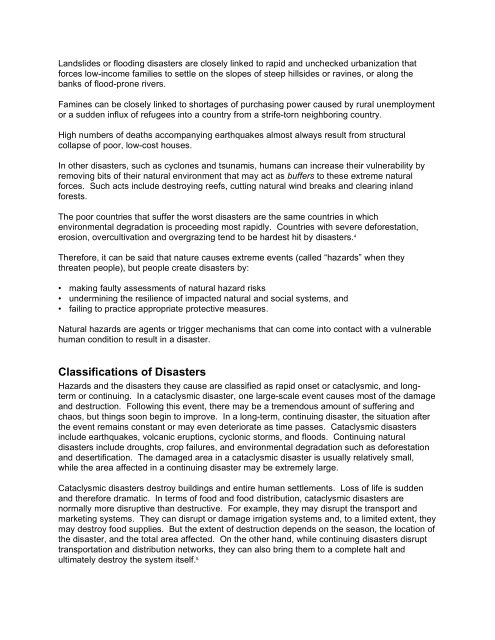Natural Hazards: Causes and Effects - Disaster Management Center ...
Natural Hazards: Causes and Effects - Disaster Management Center ...
Natural Hazards: Causes and Effects - Disaster Management Center ...
You also want an ePaper? Increase the reach of your titles
YUMPU automatically turns print PDFs into web optimized ePapers that Google loves.
L<strong>and</strong>slides or flooding disasters are closely linked to rapid <strong>and</strong> unchecked urbanization that<br />
forces low-income families to settle on the slopes of steep hillsides or ravines, or along the<br />
banks of flood-prone rivers.<br />
Famines can be closely linked to shortages of purchasing power caused by rural unemployment<br />
or a sudden influx of refugees into a country from a strife-torn neighboring country.<br />
High numbers of deaths accompanying earthquakes almost always result from structural<br />
collapse of poor, low-cost houses.<br />
In other disasters, such as cyclones <strong>and</strong> tsunamis, humans can increase their vulnerability by<br />
removing bits of their natural environment that may act as buffers to these extreme natural<br />
forces. Such acts include destroying reefs, cutting natural wind breaks <strong>and</strong> clearing inl<strong>and</strong><br />
forests.<br />
The poor countries that suffer the worst disasters are the same countries in which<br />
environmental degradation is proceeding most rapidly. Countries with severe deforestation,<br />
erosion, overcultivation <strong>and</strong> overgrazing tend to be hardest hit by disasters. 4<br />
Therefore, it can be said that nature causes extreme events (called “hazards” when they<br />
threaten people), but people create disasters by:<br />
• making faulty assessments of natural hazard risks<br />
• undermining the resilience of impacted natural <strong>and</strong> social systems, <strong>and</strong><br />
• failing to practice appropriate protective measures.<br />
<strong>Natural</strong> hazards are agents or trigger mechanisms that can come into contact with a vulnerable<br />
human condition to result in a disaster.<br />
Classifications of <strong>Disaster</strong>s<br />
<strong>Hazards</strong> <strong>and</strong> the disasters they cause are classified as rapid onset or cataclysmic, <strong>and</strong> longterm<br />
or continuing. In a cataclysmic disaster, one large-scale event causes most of the damage<br />
<strong>and</strong> destruction. Following this event, there may be a tremendous amount of suffering <strong>and</strong><br />
chaos, but things soon begin to improve. In a long-term, continuing disaster, the situation after<br />
the event remains constant or may even deteriorate as time passes. Cataclysmic disasters<br />
include earthquakes, volcanic eruptions, cyclonic storms, <strong>and</strong> floods. Continuing natural<br />
disasters include droughts, crop failures, <strong>and</strong> environmental degradation such as deforestation<br />
<strong>and</strong> desertification. The damaged area in a cataclysmic disaster is usually relatively small,<br />
while the area affected in a continuing disaster may be extremely large.<br />
Cataclysmic disasters destroy buildings <strong>and</strong> entire human settlements. Loss of life is sudden<br />
<strong>and</strong> therefore dramatic. In terms of food <strong>and</strong> food distribution, cataclysmic disasters are<br />
normally more disruptive than destructive. For example, they may disrupt the transport <strong>and</strong><br />
marketing systems. They can disrupt or damage irrigation systems <strong>and</strong>, to a limited extent, they<br />
may destroy food supplies. But the extent of destruction depends on the season, the location of<br />
the disaster, <strong>and</strong> the total area affected. On the other h<strong>and</strong>, while continuing disasters disrupt<br />
transportation <strong>and</strong> distribution networks, they can also bring them to a complete halt <strong>and</strong><br />
ultimately destroy the system itself. 5








